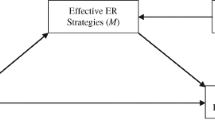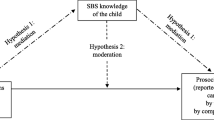Abstract
The overall aim of the present study was to investigate ADHD symptoms in relation to attachment representations. We used both attachment- and non-attachment-related story stems, which allowed us to investigate whether problems with narrative production can explain the relation between ADHD symptoms and attachment representations. We also investigated the role of cognitive deficits and conduct problems in these relations. The sample consisted of 89 children (27 % girls) between 6 and 10 years old, with an oversampling of children with high levels of ADHD symptoms. ADHD symptoms and conduct problems were rated by parents and teachers. Cognitive functioning was investigated using laboratory tests of inhibition, working memory and sustained attention. Attachment representations were coded as secure, organized insecure and disorganized categories. Narrative responses to non-attachment-related story stems were coded for incoherence and negative content. Results showed that children in the disorganized attachment category had significantly higher levels of ADHD symptoms compared to those in the secure category. Both ADHD symptoms and disorganized attachment were related to incoherence and negative content. Attachment representations were not associated with ADHD symptoms when controlling for negative content in response to non-attachment-related story stems. These results suggest that the associations between attachment security and ADHD are yet to be fully understood. Importantly, a propensity to envisage negative events seems to characterize children with high levels of ADHD symptoms.
Similar content being viewed by others
References
Achenbach, T. M., & Edelbrock, C. S. (1981). Behavioral problems and competencies reported by parents of normal and disturbed children aged 4 through 16. Monographs of the Society for Research in Child Development, 46, 1–82.
American Psychiatric Association. (1994). Diagnostic and statistical manual of mental disorders: DSM-IV (4th ed.). Washington DC: American Psychiatric Association.
Association, A. P. (2000). Diagnostic and statistical manual of mental disorders : DSM-IV-TR. (4th ed., text revision.). Washington DC: American Psychiatric Association.
Bauermeister, J. J., Shrout, P. E., Ramírez, R., Bravo, M., Alegría, M., Martínez-Taboas, A., et al. (2007). ADHD correlates, comorbidity, and impairment in community and treated samples of children and adolescents. Journal of Abnormal Child Psychology, 35, 883–898.
Berlin, L., & Bohlin, G. (2002). Response inhibition, hyperactivity, and conduct problems among preschool children. Journal of Clinical Child and Adolescent Psychology, 31, 242–251.
Berwid, O.G., Curko Kere, E.A., Marks, D.J., Santra, A., Bender, H.A., & Halperin, J.M. (2005). Sustained attention and response inhibition in young children at risk for Attention Deficit/Hyperactivity Disorder. 46, 1219–1229.
Biederman, J., Faraone, S. V., & Monuteaux, M. C. (2002). Differential effect of environmental adversity of gender: Ruttervi index of adversity in a group of boys and girls with and without ADHD. American Journal of Psychiatry, 159, 1556–1562.
Bohlin, G., Eninger, L., Brocki, K. C., & Thorell, L. B. (2012). Disorganized attachment and inhibitory capacity: predicting externalizing problem behaviors. Journal of Abnormal Child Psychology, 40, 449–458.
Bretherton, I., & Oppenheim, D. (2003). The MacArthur story stem battery: Development, administration, reliability, validity, and reflections about meaning. In R. N. Emde, D. P. Wolf, & D. Oppenheim (Eds.), Revealing the inner worlds of young children: The MacArthur Story Stem Battery and parent child narratives (pp. 55–80). Oxford: Oxford University Press.
Bretherton, I., Ridgeway, D., & Cassidy, J. (1990). Assessing internal working models of the attachment relationship. In M. Greenberg, D. Cicchetti, & E. M. Cummings (Eds.), Attachment in the preschool years: Theory, research, and intervention (pp. 273–308). Chicago: University of Chicago Press.
Counts, C. A., Nigg, J. T., Stawicki, J. A., Rappley, M. D., & Von Eye, A. (2005). Family adversity in DSM-IV ADHD combined and inattentive subtypes and associated disruptive behavior problems. Journal of the American Academy of Child and Adolescent Psychiatry, 44, 690–698.
Crick, N. R., & Dodge, K. A. (1994). A review and reformulation of social information-processing mechanisms in children’s social adjustment. Psychological Bulletin, 115, 74–101.
Dunn, J., & Hughes, C. (2001). “I got some swords and you’re dead!”: Violent fantasy, antisocial behavior, friendship, and moral sensibility in young children. Child Development, 72, 491–505.
DuPaul, G. J., Thomas, J., & Anastopoulos, A. D. (1998). ADHD rating scale-iv: Checklists, Norms, and Clinical Interpretation. New York: Guilford Press.
Emde, R. N., Wolf, D., & Oppenheim, D. (2003). Revealing the inner worlds of young children: The MacArthur Story Stem Battery and parent-child narratives. Oxford: Oxford University Press.
Fearon, R., Bakermans-Kranenburg, M. J., van Ijzendoorn, M. H., Lapsley, A. M., & Roisman, G. I. (2010). The significance of insecure attachment and disorganization in the development of children’s externalizing behavior: a meta-analytic study. Child Development, 81, 435–456.
Flory, K., Milich, R., Lorch, E. P., Hayden, A. N., Strange, C., & Welsh, R. (2006). Online story comprehension among children with ADHD: which core deficits are involved? Journal of Abnormal Child Psychology, 34, 850–862.
George, C., & Solomon, J. (2000). Six-year attachment doll play classification system. In: Unpublished classification manual. Oakland: Mills College.
Gerstadt, C. L., Hong, Y. J., & Diamond, A. (1994). The relationship between cognition and action: performance of children-7 years old on a stroop-like day-night test. Cognition, 53, 129–153.
Goldwyn, R., Stanley, C., Smith, V., & Green, J. (2000). The Manchester Child Attachment Story Task: relationship with parental AAI, SAT and child behaviour. Attachment & Human Development, 2, 71–84.
Greenberg, M. T., DeKlyen, M., Speltz, M. L., & Endriga, M. C. (1997). The role of attachment processes in externalizing psychopathology in young children. In L. Atkinson & K. J. Zucker (Eds.), Attachment and psychopathology (pp. 196–222). New York: Guilford.
Holmberg, J., Robinson, J., Corbitt-Price, J., & Wiener, P. (2007). Using narratives to assess competencies and risks in young children: experiences with high risk and normal populations. Infant Mental Health Journal, 28, 647–666.
Kline, R. B. (1998). Principles and practice of structural equation modeling. New York: Guilford Press.
Kraemer, H. C., Noda, A., & O’Hara, R. (2004). Categorical versus dimensional approaches to diagnosis: methodological challenges. Journal of Psychiatric Research, 38, 17–25.
Larsson, H., Anckarsater, H., Råstam, M., Chang, Z., & Lichtenstein, P. (2012). Childhood attention-deficit hyperactivity disorder as an extreme of a continuous trait: a quantitative genetic study of 8,500 twin pairs. Journal of Child Psychology and Psychiatry, 53, 73–80.
Lorch, E. P., Milich, R., Flake, R. A., Ohlendorf, J., & Little, S. (2010). A developmental examination of story recall and coherence among children with ADHD. Journal of Abnormal Child Psychology, 38, 291–301.
McInerney, R. J., Hrabok, M., & Kerns, K. A. (2005). The children’s size-ordering task: a new measure of nonverbal working memory. Journal of Clinical and Experimental Neuropsychology, 27, 735–745.
Oppenheim, D., & Waters, H. S. (1995). Narrative process and attachment representations: issues of development and assessment. Monographs of the Society for Research in Child Development, 60, 197–215.
Pinto, C., Turton, P., Hughes, P., White, S., & Gillberg, C. (2006). ADHD and infant disorganized attachment. Journal of Attention Disorders, 10, 83–91.
Renz, K., Lorch, E. P., Milich, R., Lemberger, C., Bodner, A., & Welsh, R. (2003). On-line story representation in boys with attention deficit hyperactivity disorder. Journal of Abnormal Child Psychology, 31, 93–104.
Rutter, M., Tizard, J., & Whitmore, K. (1970). Education, health and behaviour. Longman Publishing Group.
Sher-Censor, E., & Oppenheim, D. (2004). Coherence and representations in preschoolers’ narratives: Associations with attachment in infancy. In M. W. Pratt & B. H. Fiese (Eds.), Family stories and the life course (pp. 77–108). Mahwah, NJ: Erlbaum.
Solomon, J., & George, C. (2008). The measurement of attachment security and related constructs in infancy and early childhood. In J. Cassidy & P. R. Shaver (Eds.), Handbook of attachment: Theory, research, and clinical applications. New York: The Guilford Press.
Solomon, J., George, C., & De Jong, A. (1995). Children classified as controlling at age six: evidence of disorganized representational strategies and aggression at home and at school. Development and Psychopathology, 7, 447–463.
Sonuga-Barke, E. J., Dalen, L., & Remington, B. (2003). Do executive deficits and delay aversion make independent contributions to preschool attention-deficit/hyperactivity disorder symptoms? Journal of the American Academy of Child and Adolescent Psychiatry, 42, 1335–1342.
Tannock, R., Purvis, K. L., & Schachar, R. J. (1993). Narrative abilities in children with attention deficit hyperactivity disorder and normal peers. Journal of Abnormal Child Psychology, 21, 103–117.
Thorell, L. B., Rydell, A.-M., & Bohlin, G. (2012). Parent–child attachment and executive functioning in relation to ADHD symptoms in middle childhood. Attachment & Human Development, 14, 517–532.
van Ijzendoorn, M. H., Schuengel, C., & Bakermans-Kranenburg, M. J. (1999). Disorganized attachment in early childhood: meta-analysis of precursors, concomitants, and sequelae. Development and Psychopathology, 11, 225–250.
von Klitzing, K., Kelsay, K., Emde, R. N., Robinson, J. A., & Schmitz, S. (2000). Gender-specific characteristics of 5-year-olds’ play narratives and associations with behavior ratings. Journal of the American Academy of Child and Adolescent Psychiatry, 39, 1017–1023.
Warren, S. L., Oppenheim, D., & Emde, R. N. (1996). Can emotions and themes in children’s play predict behavior problems? Journal of the American Academy of Child and Adolescent Psychiatry, 35, 1331–1337.
Weschler, D. (2003). Wechsler Intelligence Scale for Children–Fourth Edition (4th ed.). San Antonio: Pscyhological Corporation.
Willcutt, E. G., Doyle, A. E., Nigg, J. T., Faraone, S. V., & Pennington, B. F. (2005). Validity of the executive function theory of attention-deficit/hyperactivity disorder: a meta-analytic review. Biological Psychiatry, 57, 1336–1346.
Zahn-Waxler, C., Cole, P. M., Richardson, D. T., & Friedman, R. J. (1994). Social problem solving in disruptive preschool children: reactions to hypothetical situations of conflict and distress. Merrill-Palmer Quarterly, 40, 98–119.
Conflict of Interest
We have no interests to declare.
Author information
Authors and Affiliations
Corresponding author
Additional information
Author Note
This research was supported by a grant from The Swedish Council for Working Life and Social Research to Gunilla Bohlin
Rights and permissions
About this article
Cite this article
Scholtens, S., Rydell, AM., Bohlin, G. et al. ADHD Symptoms and Attachment Representations: Considering the Role of Conduct Problems, Cognitive Deficits and Narrative Responses in Non-Attachment-Related Story Stems. J Abnorm Child Psychol 42, 1033–1042 (2014). https://doi.org/10.1007/s10802-014-9854-0
Published:
Issue Date:
DOI: https://doi.org/10.1007/s10802-014-9854-0




